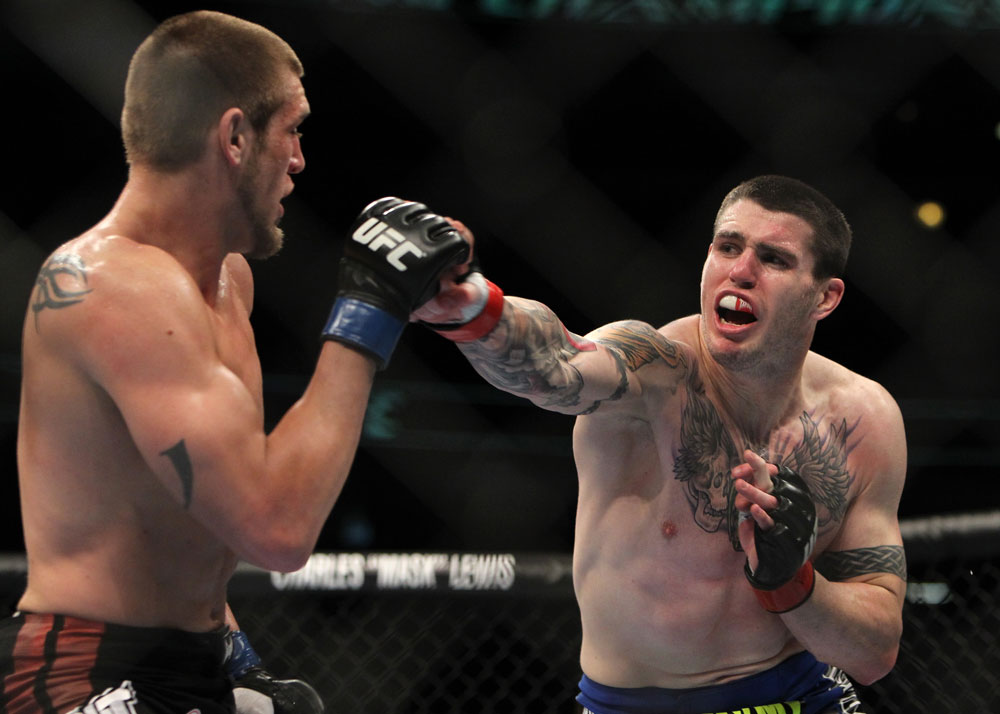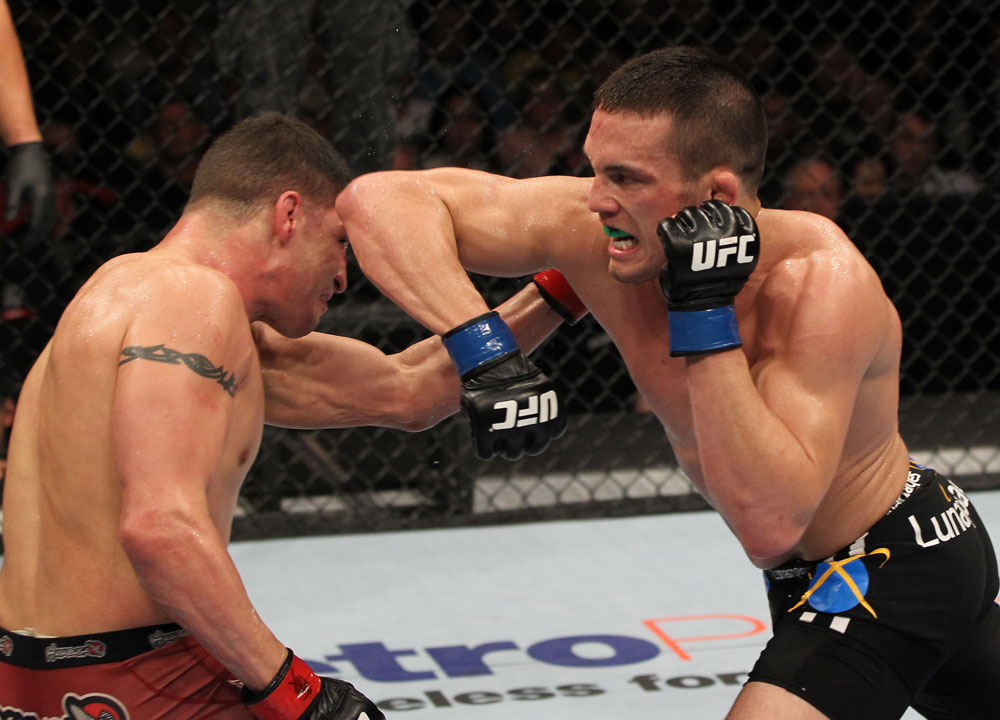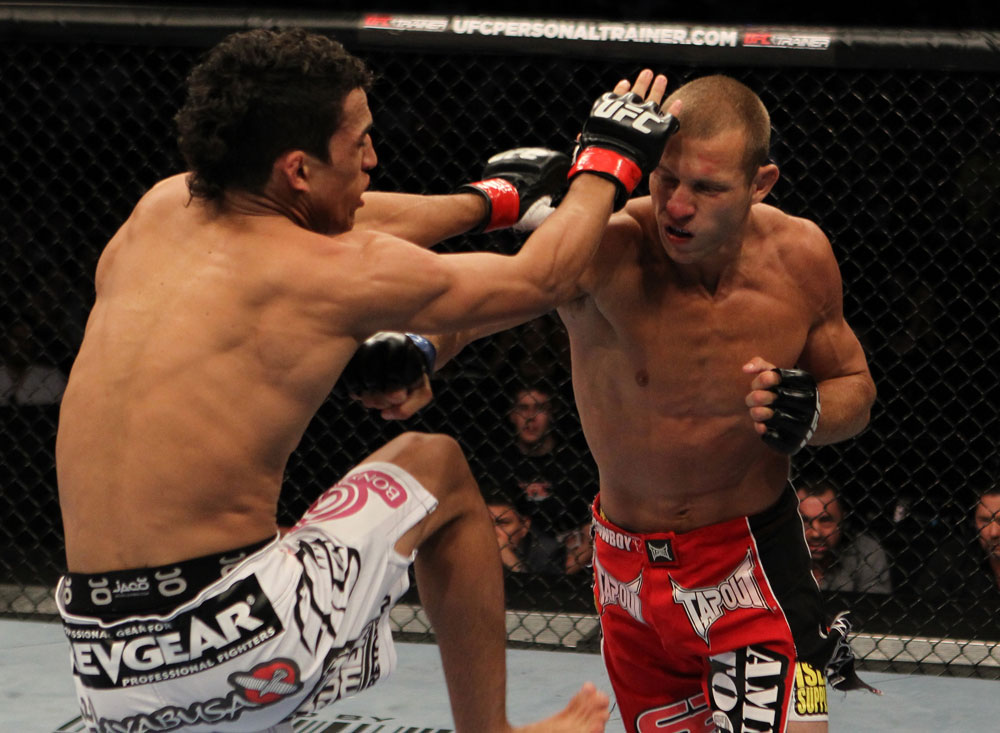 Chris Camozzi is playing to win. And he’s playing hard.
Chris Camozzi is playing to win. And he’s playing hard.
Camozzi – denied an opportunity at a six-figure UFC contract when a broken jaw forced his removal from Season 11 of The Ultimate Fighter – isn’t just determined to achieve mortal victory. By the time he steps back inside the Octagon June 22 at UFC on FX 4 in Atlantic City, N.J., against hometown middleweight Nick Catone, the object is not only doing everything to ensure victory, but to shock fans out of their seats with cries of, “Holy [smokes]!”
Maybe you forgot about Camozzi, 12-3 competing in shows near his native Lakewood, Colorado, before a national television audience saw him break Victor O’Donnell’s orbital bone to gain entry into the house — at a heavy price. Perhaps you dismissed him after a tap out loss to Kyle Noke on February 27, 2011 led to his release. Maybe his nip-and-tuck defeat to Francis Carmont at UFC 137 in his return bout flew under your radar, but there is something deep in Camozzi’s spirit, which he let out on his fan community page a month or so before his trip to Atlantic City.
It was weeks earlier when the UFC announced its seven-year partnership with the FOX networks. And judging from what Camozzi wrote, you’d figure he was a whiz-kid marketing guru and not someone who attended Fort Lewis College for a year before dropping out. Someday, some way, Camozzi believes he can attract major companies and do commercials to certify mixed martial arts as a mainstream sport. A win over Catone is a small step for the fighter and a quantum leap for Chris Camozzi Inc., the making of a brand which leads MMA and the UFC to rarefied heights reserved for Major League Baseball or the National Football League.
“I think I am that guy,” Camozzi said with relaxed confidence. “I have to string a few wins together and make them notice me. The business side, I feel like I’m a good face for the sport. I’m honest and don’t try to make myself look better than I am. I have my faults. A lot of guys try to perceive themselves as perfect. I’m just an everyday guy I think other people can relate to. Once I put some wins together I think I would be one of those faces they would like to get behind.”
Camozzi’s management company, Ingrained Media, has developed a strategy that refuses to settle for a fight every few months before disappearing from public view. It never ends with mere victory, not for Camozzi. He’s dogged in his pursuit to become must-see TV, when fans drop everything and plan their agenda around his next night of combat.
“It’s about being remembered,” Camozzi said. “Nobody cares if you win playing it safe. I think that relates more to my personality too. I said a long time ago the person I’d love to be would be Chris Lytle. Everybody knows no matter who he’s fighting he’s going to be great. That’s somebody I’d love to be like, one of those guys who if you turn on the TV it doesn’t matter if he’s fighting Joe Schmo, people are like, ‘Oh my God. You gotta watch this.’”
Of Camozzi’s 16 MMA wins, six have gone the distance and another six have ended via submission, including his last bout in January, when his guillotine choke forced Dustin Jacoby to surrender 1:08 into round three. The next level of evolution to solve Catone, an accomplished high school wrestler competing in his first bout in 15 months after recovering from a torn Achilles tendon, was to improve the weakest part of his game, on the mats. At the Englewood, Colorado-based Factory X Muay Thai MMA facility, he trained with Olympic caliber wrestlers and accepted an invite to West Linn, Oregon, to work with a former NCAA Division I champion and Greco-Roman wrestling Olympic alternate named Chael Sonnen.
“I think I’ll walk in there as a better wrestler as far as MMA is concerned,” Camozzi said. “I’m training with guys on another level.”
Where Sonnen is blunt, brash and outspoken, Camozzi is reserved with a quiet confidence, but a bit of Sonnen swagger has rubbed off on the 25-year-old Brazilian jiu-jitsu purple belt. For the fourth time in five fights, Camozzi is competing in enemy territory. Catone grew up in Brick Township, N.J., not far from Atlantic City. Camozzi traveled to Sydney, Australia, for the ill-fated battle with Noke, but neutralized homefield advantages with victories over Joey Villasenor and Jacoby in Rio Rancho, New Mexico, and Chicago, respectively. Not unlike many fighters, Camozzi’s adrenaline flows when he’s booed. Like a select few, he trains in Denver, where the altitude does a number on your ability to breathe.
“Everywhere I fight I have the hometown advantage,” Camozzi said. “I don’t ever think the other guy does. I fight out of Denver, Colorado. We’re higher than just about everybody. I have the hometown advantage because I’m coming down in altitude. What he feels like in the first round is what I feel like in the third round. If the crowd boos me, I don’t care. It pumps me up.
“The hometown guy always has to perform in front of friends and family, and everybody he knows. I get to go to these guys’ hometown and not have all the pressure on me, not having every single person I know in the crowd and performing in front of them. Granted, I’m bringing a big group of people so (laughs) … I’m hoping one day I get to fight in Denver. Maybe I’ll eat my words and the pressure will be put back on me, but it’s a win-win situation.”
Despite Vince Lombardi’s enduring words, in Camozzi’s world there is more to fighting than winning – much more. It’s a brick used to build the Camozzi brand, to make money without fighting. “You have to build your name, build that brand,” Camozzi said. Working with Ingrained Media has prodded him to find something both marketable and different. You have your garbage talkers, good guys and bad guys. Camozzi needs to deduce what makes him stick out.
“I’m still searching for that, but I feel like I’m starting to find it,” Camozzi said. “When somebody watches me fight they know I’m not going to quit. I’m one guy who fans can rely on to put on a fight, push the pace and never quit in the corner.”
 Jake Ellenberger
Jake Ellenberger


